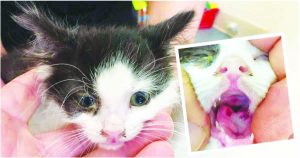 We advised last week that, in addition to a few other infectious agents, two virus groups are primarily involved in this respiratory disease complex that affects cats.
We advised last week that, in addition to a few other infectious agents, two virus groups are primarily involved in this respiratory disease complex that affects cats.
For our purposes, it is quite immaterial which virus afflicts the animal, since the symptoms are pretty much the same. In any case, no general practitioner of the veterinary medical art/ science in Guyana would have the capability to diagnose which specific virus is making the cats sick. So, the vet would logically be treating the symptoms.
Now, these sympto ms can exhibit themselves in various ways, and with varying degrees of severity. In some affected cats, the expression of the malady is hardly noticeable. On the other hand, the disease could be forceful, and the symptoms very pronounced, often leading to death.
ms can exhibit themselves in various ways, and with varying degrees of severity. In some affected cats, the expression of the malady is hardly noticeable. On the other hand, the disease could be forceful, and the symptoms very pronounced, often leading to death.
The acute infection
The disease, as advised last week, is transmitted via aerosol droplets. Symptoms may go through an entire process, lasting weeks. Firstly, they are mild, then they become harsh.
The mild symptoms begin with a clear fluid being discharged from the nostrils and eyes. This is accompanied by sneezing. Usually, an increased body temperature is also present. So, you see why people call it ‘Cat Flu’ – except that cats don’t catch colds and don’t have influenza, as we humans do.
Later, secretions in the eye and nose become thicker. As the animal is weakened, other germs (especially bacteria) have a good chance at invading the respiratory system. The discharge then becomes yellow and sticky (pus).
At just about this time, the oral cavity may show signs of tissue loss. There is an erosion of the thin membrane covering the mucous membrane lining of not only the inside of the mouth, but also of the throat, windpipe, and even of the lungs and nasal passages. Obviously, the cat would not want to eat or drink.
Whenever ulceration in the mouth occurs, there is a lot of drooling, and strings of slime hang from the corners of the mouth.
In more advanced stages of the disease, the cat/kitten can go blind, partially or totally, because of all the viral attacks on the eye and the consequential ulceration on the eyeball.
When all these symptoms exhibit themselves, things begin to look bleak for the cat. By now the ailing animal should have been in the care of your vet.
At this stage, the viruses are being shed in large numbers, and other cats in the vicinity can be infected. As much as is possible, the sick cat must be isolated.
I have mentioned before that humans cannot catch ‘Feline Influenza’.
Next week, we’ll deal with the treatment and prevention of this killer disease.
Do have an enjoyable Easter Season!
 We advised last week that, in addition to a few other infectious agents, two virus groups are primarily involved in this respiratory disease complex that affects cats.
We advised last week that, in addition to a few other infectious agents, two virus groups are primarily involved in this respiratory disease complex that affects cats. ms can exhibit themselves in various ways, and with varying degrees of severity. In some affected cats, the expression of the malady is hardly noticeable. On the other hand, the disease could be forceful, and the symptoms very pronounced, often leading to death.
ms can exhibit themselves in various ways, and with varying degrees of severity. In some affected cats, the expression of the malady is hardly noticeable. On the other hand, the disease could be forceful, and the symptoms very pronounced, often leading to death.